List of Armenian monarchs
This is a list of the kings and queens of Armenia, for more information on ancient Armenia and Armenians, please see History of Armenia. For information on the medieval Armenian Kingdom in Cilicia, please see the separate page Armenian Kingdom of Cilicia.
See List of kings of Urartu for kings of Urartu (Ararat), the predecessor state of Greater Armenia.
Greater Armenia
This is the historical designation of the largest and longest-lasting Armenian kingdom.
Orontid kings and satraps
In Armenian tradition
Early kings in traditional Armenian chronology according to Moses of Chorene.
Note that the early dates are traditional and of uncertain accuracy.
- Orontes I Sakavakyats (570–560 BC)
- Tigranes Orontid (560–535 BC)
- Vahagn (530–515 BC)
- Hidarnes I (late 6th century BC)
- Hidarnes II (early 5th century BC)
- Hidarnes III (middle of the 5th century BC)
- Ardashir (2nd half of the 5th century BC)
Attested satraps
- Orontes (401–344 BC)
- Darius Codomannus (344–336 BC)
Yervandian (Yervanduni or Orontid) Dynasty
- Orontes II (336–331 BC)
- Mithranes (331–323 BC)
- Neoptolemus Orontid (non-dynastic) (323–321 BC)
- Mithranes (321–317 BC)
- Orontes III (317–260 BC)
- Sames (260–243 BC)
- Arsames (243–228 BC)
- Xerxes (228–212 BC)
- Orontes IV (212–200 BC)
- Artaxias I (190–159 BC)
- Artavasdes I (159–123 BC)
- Tigranes I (123–95 BC)
- Tigranes the Great (Tigranes II, 95–55 BC)
- Artavasdes II (55–34 BC)
- Artaxias II (33–20 BC)
- Tigranes III (20–10 BC)
- Tigranes IV with Erato (10 BC–2 BC)
- Ariobarzanes, 2 BC to 4 (Roman protectorate)
- Artavasdes III[contradictory] 4 to 6
- Tigranes V, 6 then ruled with Erato 6–12
- Vonones (former king of Parthia) 12–16 (Roman protectorate)
- Roman interregnum 16–18 (Vonones as nominal king)
- Artaxias III 18–35 (Roman protectorate)
- Arsaces I of Armenia (son of Artabanus III) 35 (Parthian protectorate)
- Orodes of Armenia (pretender, son of Artabanus III) 35
- Mithridates 35–37 (Roman protectorate)
- Orodes (now king) 37–42 (Parthian protectorate)
- Mithridates (second time) 42–51 (Roman protectorate)
- Rhadamistus (son of Pharasmanes I of Iberia) 51–53 (Roman protectorate)
- Tiridates I (son of Vonones II of Parthia) 53 (Roman protectorate)
- Rhadamistus (second time) 53–54 (Roman protectorate)
- Tiridates I (second time) 52–58
- Tigranes VI 59–62 (Roman protectorate)
- Tiridates I 62–88 (Parthian protectorate 62–63; from 63 Armenia again becomes a Roman protectorate)
- Sanatruces (Sanatruk) 88–110
- Axidares (Ashkhadar) 110–113
- Parthamasiris (Partamasir) 113–114
- Roman Province 114–117/8
- Vologases I (Vagharsh I) 117/8–144
- Sohaemus 144–161
- Bakur 161–164
- Sohaemus (second time) 163/4–186?
- Vologases II (Vagharsh II) 186–198
- Khosrov I 198–217
- Tiridates II 217–252
- Khosrov II c. 252
- Sassanid Occupation 252–287
- Artavasdes IV 252–287 Sassanid Client King
- Tiridates III 287–330 (Roman protectorate again)
- Khosrov III 330–339
- Tigranes VII (Tiran) 339 – c. 350
- Arsaces II (Arshak II) c. 350–368
- Sassanid Occupation 368
- Papas (Pap) 370–374
- Varasdates (Varazdat) 374–378
- Arsaces III (Arshak III) 378–387 with co-ruler Vologases III (Vagharsh III) 378–386
- Khosrov IV 387–389
- Vramshapuh 389–417
- Local Independent Government 417–422
- Artaxias IV (Artashir IV) 422–428
Marzpanate
- Veh Mihr Shapur 428–442
Vartan Mamikonian [AKA Vartan Zoravar, legendary Armenian general killed in battle but preserved Armenia as first Christian nation in the world]
- Adhur Hormizd (Adrormizd) 451–465
- Adhur Gushnasp (Ardervechnasp) 465–481
- Sahak Bagratuni 481–482
Military occupation by General Shapur Mihran 482
- Vahan Mamikonian (provisional) 482–483
- Zarmihr Hazarwuxt (military occupation) 483
- Shapur of Ray 483–484
- Vahan Mamikonian (second time) 484–505/510 (provisional government 484–485)
- Vard Mamikonian (brother) 505/510–509/514
- Gushnasp Vahram ? 509/514–518
- Mjej I Gnuni 518–548
- Tan-Shapur 548–552
- Gushnasp Vahram (second time?) 552–554
- Tan-Shapur (second time) 554–558/60
- Varazdat 558/560–564
- Chihor-Vishnasp 564–572
- Golon Mihran 572-574
- Tamkhosrau 577–580
- Varaz Vzur 580–581
- Aspahbad Pahlav 581–582/588
- Frahat 582/588–588/589
- Hratzin 588/589–590
- To Byzantium 590
- Mushegh II Mamikonian 590–591 (governor)
- Hamarakar 591 (governor)
- Unknown 591–603 (governors)
- Smbat IV Bagratuni 603–611
- Shahrayanpet (in the East) 611–613
- Shahin Vahmanzadaghan (in the West) 611–613
- Parsayenpet 613–616
- Namdar Gushnasp 616–619
- Shahraplakan (Sarablagas) 619–624
- Rozbihan 624–627
- Byzantine province 627–628
- Varaztirots Bagratuni 628–634
- Unknown 634–?
- Mjej Gnuni 627–635
- Vahan 636
- Davith Saharuni 636–638
- Several "nakharar" 638–643
- Theodore Rshtuni 643–645
- Varaztirots Bagratuni 645–646
Presiding Princes of Armenia
| Ruler | Reign | Family | Notes |
|---|---|---|---|
| Varaztirots II | 645–646 | Bagratuni | First presiding Prince of Armenia. |
| Smbat V | 646–653 | Bagratuni | Son of Varaztirots II. Together with Theodore. |
| Theodore | Rshtuni | 1st time. | |
| Smbat V | 653 | Bagratuni | Expelled Theodoros, but he returned to power that same year. |
| Theodore | 653–654 | Rshtuni | 2nd time. |
| Musel IV | 654 | Mamikonian | Expelled Theodoros, but he returned to power that same year. |
| Theodore | 654–655 | Rshtuni | 3rd time. Under his third rule, Maurianos, a Byzantine governor, was installed in Armenia. |
| Hamazasp | 655–661 | Mamikonian | |
| Grigor I | 661–685 | Mamikonian | |
| Ashot II | 685–690 | Bagratuni | |
| Nerseh | 690–693 | Kamsarakan | |
| Smbat VI Kouropalates | 691–693 | Bagratuni | Son of Varaztirots III Bagratuni. Jointly with Nerseh. 1st time. |
| Muslim Protectorate: 693–695 | |||
| Smbat VI Kouropalates | 695–705 | Bagratuni | 2nd time. |
| Umayyad Protectorate: 705–711; Vacancy: 711–726 | |||
| Artavazd | 726–732 | Kamsarakan | |
| Ashot III the Blind | 732–745 | Bagratuni | 1st time |
| Grigor II | 745–746 | Mamikonian | 1st time |
| Ashot III the Blind | 746–750 | Bagratuni | 2nd time |
| Grigor II | 750–751 | Mamikonian | 2nd time |
| Musel VI | 751 | Mamikonian | Brother of Grigor II. |
| Arab Occupation: 751–754 | |||
| Sahak III | 754–761 | Bagratuni | Also Lord of Taron |
| Smbat VII | 761–775 | Bagratuni | |
| Vacancy: 775–806 | |||
| Ashot IV the Carnivorous | 806–826 | Bagratuni | |
| Smbat VIII | 826–855 | Bagratuni | Joint rule with his brother Bagrat 830-52[1] |
| Bagrat II | 830–852 | Bagratuni | Joint rule with his brother Smbat VIII. |
| Ashot V the Great | 806–826 | Bagratuni | |
Armenian Bagratid kingdom and vassals
Kings of Armenia (885–1045)
- 885–890: Ashot I the Great
- 890–914: Smbat I the Martyr
- 914–928: Ashot II the Iron
- 928–952: Abas I
- 952–977: Ashot III the Merciful
- 977–989: Smbat II the Conqueror
- 989–1020: Gagik I
- 1020–1040: Hovhannes-Smbat (III)
- 1021–1039: Ashot IV the Valiant, concurrently in certain regions after rebellion against Hovhannes
- 1042–1045: Gagik II, deposed, died c. 1079
- To the Byzantine Empire (1045–1064)
- To the Turko-Persian Seljuk Empire (1064–1072)
- To the Muslim Shaddadids (1072–1199).
Kings and Lords of Lori (979–1259)
Bagratuni dynasty as kings
- 979–989: Gurgen I (also spelled Kiurike), son of Ashot III of Ani
- 989–1048: David I the Landless, temporarily lost his lands to the king of Ani
- c.1000: Smbat I, brother and co-ruler
- 1048–1089: Gurgen II (also spelled Kiurike)
- c.1063: Smbat II, brother and co-ruler
- 1089–1118: David II
- 1089–1118: Abas I, brother and co-ruler
From 1118 the Kingdom of Lori became the Lordship of Matznaberd and Tavouch. The Kingdom was annexed by the Turks.
Bagratuni dynasty as lords
- 1118–1145: David II
- 1118–1145: Abas I, brother and co-ruler
- 1145–1185: Gurgen III
- 1185–1192: Abas II
- 1192–1236: Aghsartan, illegitimate son of Abas II
- 1232–1236: Gurgen IV, son of Aghsartan and his co-ruler
- 1236–1256: Pahlavan
- 1256–1259: Taqiaddin
Kings of Kars (962–1064)
- 962–984: Mousel, son of Abas I of Ani
- 984–1029: Abas I, son of the above
- 1029–1064: Gagik-Abas II (d.1080), son of the above, surrendered the kingdom to the Byzantine Empire
Princes and Kings of Vaspurakan (800–1021)
Artsruni dynasty as princes
- 800–836: Hamazasp II, married to a daughter of Ashot Msaker of the Bagratuni family.
- 836–852: Ashot I Abulabus, son, 1st time
- 852–853: Gurgen I, brother of the above
- 853–854: Abu Djafar, probably brother of the above
- 854–857: Gurgen II, a distant relative from Mardastan
- 857–868: Grigor-Derenik, son of Ashot I, married Sofia, daughter of Ashot I Bagratuni. 1st time
- 868–874: Ashot I Abulabus, 2nd time
- 874–887: Grigor-Derenik, 2nd time.
- 887–898: Gagik Abu Morvan Artsruni, regent for Grigor-Derenik's sons, then usurper from 896
- 898–900: Ashot II Sargis, son of Grigor-Derenik.
- (Vaspurakan occupied in 900-01 by the Sajid emir Afshin)
- Safi, governor
- 901–904: Ashot II Sargis, reinstated. After his death Vaspurakan is divided:
- 904–908: Gagik III, brother of Ashot II, ruler in northwest Vaspurakan, crowned king 908
- 904–925: Gurgen III, brother of Ashot II, ruler in southeast Vaspurakan.
Artsruni dynasty as kings
- 908/25-943: Gagik I (III), brother of Ashot II, ruler in northwest, reunited Vaspurakan 925
- 943–953: Derenik-Ashot I (III), son of the above
- 953–972: Abusahl-Hamazasp, brother of the above
- 972–983: Ashot II Sahak (IV), son of the above
- 983–1003: Gurgen I Khachik (IV), brother of the above, also lord of Antzevasiq.
- 1003–1021: Seneqerim-Hovhannes, brother of the above, also lord of Rechtuniq.
Kings of Syunik (987–1170)
- 987–998: Smbat I Sahak
- 998–1040: Vasak, son of the above
- 1040-1044/51: Smbat II, maternal grandson of the above
- 1044/51-1072: Grigor I, brother of the above
- 1072–1094: Seneqerim, brother-in-law of the above
- 1094–1166: Grigor II, son of the above
- 1166–1170: Hasan, son-in-law of the above
Kings of Georgia
Bagrationi dynasty (1118–1476)
- 1118–1124: David IV the Builder
- 1125–1156: Demetrius I
- 1156–1184: George III
- 1184–1213: Tamar the Great
- 1213–1223: George IV
- 1223–1245: Rusudan
- 1245–1247: David VI
- 1247–1270: David VII
- 1270–1289: Demetrius II the Self-Sacrificer
- 1289–1292: Vakhtang II
- 1292–1311: David VIII
- 1311–1313: George VI Mtsire
- 1299–1346: George V the Brilliant
- 1346–1360: David IX
- 1360–1393: Bagrat V
- 1393–1407: George VII
- 1407–1411: Constantine I
- 1412–1442: Alexander I the Great
- 1430: Qara Iskander, ruler of Kara Koyunlu declares himself to be “Shah-i-Arman”
Armenians in exile: The Armenian Kingdom of Cilicia
The Armenian Kingdom of Cilicia was a state formed in the Middle Ages by Armenian refugees, who were fleeing the Seljuk invasion of Armenia.[2] It was initially founded by the Rubenian dynasty, an offshoot of the larger Bagratid family that at various times held the thrones of Armenia and Georgia. While the Rubenian rulers were initially regional princes, their close ties with the Western world after the First Crusade saw the principality recognised as a kingdom under Leo I by the Holy Roman Empire in 1198.[3] The Rubenid dynasty fell in 1252 after the death of the last Rubenid monarch Isabella, and her husband Hethum I became sole ruler, beginning the Hethumid dynasty. After the death of Leo IV in 1341 his cousin was elected to succeed him as Constantine II, the first king of the Lusignan dynasty. The kingdom fell at the beginning of Leo V's reign to the Mamluks,[4] and henceforth title holders were only claimants to the throne. Charlotte of Cyprus ceded the throne to the House of Savoy in 1485,[5] and the title fell out of use until after 1861.
Lords and Princes of Cilician Armenia Kings of Cilician Armenia
| Name | Portrait | Born | Reign | Marriage (s) | Death | Notes |
|---|---|---|---|---|---|---|
| Ruben I (Ռուբեն Ա) |
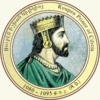
|
1025[6] or 1035 [7] Unknown |
1080–1095 | Unknown two children |
1095 Kormogolo[8] or 1035 aged 59–60 or 69–70 |
He declared the independence of Cilicia from the Byzantine Empire, thus formally founding the beginning of Armenian rule there.[9] The Roupenian dynasty ruled Cilician Armenia until 1219. |
| Constantine I (Կոստանդին Ա) |

|
Between 1035–1040[10] or between 1050–1055 Son of Ruben I |
1095-1100/1102/1103 | Unknown (great-granddaughter of Bardas Phokas) three children |
c.1100[11] or 24 February 1102 or 23 February 1103 [7] aged c. 50–60 |
He provided ample provisions to the Crusaders, for example during the difficult period of the siege of Antioch in the winter of 1097. He was a passionate adherent of the separated Armenian Church. |
| Thoros I (Թորոս Ա) |
Unknown, before 1100 First son of Constantine I |
1100/1102/1103-1129 | Unknown (great-granddaughter of Bardas Phokas) three children |
c.1129[12] or 17 February 1129 or 16 February 1130 [7] | His alliance with the leaders of the First Crusade helped him rule his feudal holdings with commanding authority. He avenged the death of King Gagik II by killing his assassins. He also bestowed favors and gave gifts and money to many monasteries for their decoration and adornment. | |
| Constantine II (Կոստանդին Բ) |
Unknown, before 1129 Son of Thoros I |
1129/1130 | Unmarried | After 17 February 1129 | He died a few months after his father's death in the course of a palace intrigue. | |
| Leo I (Լեիոն Ա) |
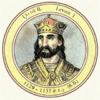
|
Unknown, before 1100 Second son of Constantine I |
1129/1130-1137 | Unknown six or seven children |
14 February 1140 Constantinople aged at least 39–40 |
Most of his successes benefited from Byzantium's pre-occupation with the threats of Zengi from Aleppo and the lack of effective Frankish rule, especially in the Principality of Antioch. He expanded his rule over the Cilician plains and even to the Mediterranean shores. He was taken captive in 1137 with two of his sons by the Byzantine Emperor. He died in prison. |
| Byzantine Rule: 1137-1144/1145 | ||||||
| Thoros II the Great (Թորոս Բ) |
1144[7] or 1145[13][14] Son of Leo I |
1144–1169 | Unknown (An unnamed daughter of Simon of Raban[15][14]) or Isabelle of Edessa[7] 1149 two children Unknown (An unnamed daughter of Thomas of Cilicia) 1164 one child |
6 February 1169[16][7][17][7] aged 23–24-25 |
Thoros survived his incarceration in Constantinople and was able to escape in 1143. He found it occupied by many Greek garrisons, ousting successfully the Byzantine garrisons. | |
| Thomas of Cilicia (Թոմաս) |
Unknown Son of a daughter of Leo I |
1169–1170 | Unknown at least one child |
1170 aged 4–5 |
Grandson of Leo I, was regent on behalf of his own grandson, Ruben II. Assassinated by prince Mleh, who took the power to himself. | |
| Ruben II (Ռուբեն Բ) |
1165 Son of Thoros II |
1169–1170 | Unmarried | 1170 aged 4–5 |
Placed under regency of his maternal grandfather, Thomas of Cilicia. Died as a minor, assassinated by his uncle Mleh. | |
| Mleh (Մլեհ) |
Before 1120 Son of Leo I |
1170–1175 | Unknown no children |
15 May 1175 Sis aged at least 54–55 |
During his father's captivity escaped to Edessa with two of his brothers. Expelled from Cilicia by Thoros II, for embracing the Muslim faith, almost undid his brother's work when he took the power. | |
| Ruben III (Ռուբեն Գ) |
1145 First son of Stephen of Armenia and Rita of Barbaron |
1175–1187 | Isabella of Toron two children |
6 May 1187[7] Drazark[18] aged 41–42 |
He was a friend of the Franks (the Crusaders); for example, at the end of 1177, assisted Philip, Count of Flanders and Prince Bohemond III of Antioch at the ineffectual siege of Harenc.[17] | |
| Leo II the Magnificent (Լեւոն Ա Մեծագործ) |
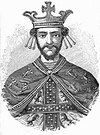
|
1150 Second son of Stephen of Armenia and Rita of Barbaron |
1187-1198/1199 | Isabella of Antioch 3 February 1188 or 4 February 1189 (annulled 1206) one child Sibylla of Cyprus 28 January 1210 or 27 January 1211 one child |
2 May 1219[7] aged 68–69 |
In 1194–1195, when he was planning to receive the title of king, he instituted a union of the Armenian church with Rome. |
| Leo II the Magnificent (Լեւոն Ա Մեծագործ) (Leo I as king) |

|
1150 Second son of Stephen of Armenia and Rita of Barbaron |
1198/1199 – 1219 | Isabella of Antioch 3 February 1188 or 4 February 1189 (annulled 1206) one child Sibylla of Cyprus 28 January 1210 or 27 January 1211 one child |
2 May 1219[7] aged 68–69 |
During his reign, succeeded in establishing Cilician Armenia as a powerful and a unified Christian state with a pre-eminence in political affairs.[19] Led his kingdom alongside the armies of the Third Crusade and aided the crusaders. Under his rule, Armenian power in Cilicia was at its apogee: his kingdom extended from Isauria to the Amanus Mountains. |
| Adam of Baghras | Unknown | 1219–1220 | Unknown | 1220 | Named regent for Isabella I. Assassinated by courtiers. | |
| Constantine of Barbaron (Կոնստանդին Գունդստաբլ) |
Unknown Son of Vassag of Barbaron |
1220–1226 | Alice Pahlavouni before 1263 six children |
1263 | Named regent for Isabella I. Married the heiress to his eldest son. | |
| Isabella I (Զապել) (jointly with Hethum I ) |

|
27 January 1216 or 25 January 1217 Daughter of Leo II the Magnificent and Sibylla of Cyprus |
1226–1252 | Philip of Antioch June 1222 no children Hethum I 14 June 1226 Tarsus seven children |
23 January 1252 aged 35–36-37 |
A period of dynastic conflict that ended with the apparent unification in marriage of the two principal dynastic forces of Cilicia (i.e., the Roupenids and the Hethumids). The country experienced struggles and shifting alliances between Crusader states and the Mongol Empire. |
| Name | Portrait | Born | Reign | Marriage (s) | Death | Notes |
|---|---|---|---|---|---|---|
| Hethum I (Հեթում Ա) (jointly with Isabella I ) |

|
1215 Son of Constantine of Barbaron and Alice Pahlavouni |
1226–1270 | Isabella I 14 June 1226 Tarsus seven children |
21 October 1270 aged 54–55 |
Was a major player in the political struggles and shifting alliances around the Crusader states, as the Armenians had ties with all sides. They were primarily aligned with the Europeans, but during Hethum's reign, the rapidly expanding Mongol Empire became a concern. |
| Leo III (Լեւոն Բ) (Leo II as king) |
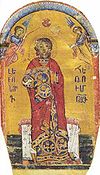
|
1236 Son of Hethum I and Isabella I |
1270–1289 | Anna of Lampron 5 January 1262 or 14 January 1263 sixteen children |
6 February 1289 aged 52–53 |
A pious king, he was devoted to Christianity. He pursued active commercial relations with the West, by renewing trade agreements with the Italians and establishing new ones with the Catalans. He also endeavoured to reinforce the Mongol alliance. |
| Hethum II (Հեթում Բ) |

|
1266 First son of Leo III and Anna of Lampron |
1289–1293 1295–1296 (as co-ruler) 1299–1303 |
Unmarried | 17 November 1307 Anazarba aged 40–41 |
Political trouble: he abdicated in 1293 for monastic vows, being recalled by his brother Thoros III in 1295. They travelled to Constantinople to marry their sister Rita to Michael IX Palaiologos, but their brother SempadI usurped the throne, and they were imprisoned in the return; Freed after Sempad's death, assumed power again in 1299, abdicating once more in 1303 to become regent for his successor, Leo IV. |
| Thoros III (Թորոս Երրորդ) (Thoros I as king) |

|
1271 Second son of Leo III and Anna of Lampron |
1293–1298 (nominally since 1296, imprisoned) |
Margaret of Cyprus 9 January 1288 two children Unknown (daughter of Mahmud Ghazan Khan) no children |
23 July 1298 aged 26–27 |
Imprisoned in 1296 by Sempad, his brother, who usurped the throne, was strangled in prison in 1298. |
| Sempad (Սմբատ) |
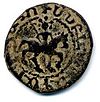
|
1277 Third son of Leo III and Anna of Lampron |
1296–1298 (usurper) |
Unknown (daughter of Mahmud Ghazan Khan) no children |
1310 aged 32–33 |
Sempad seized the throne with the aid of his brother Constantine while his brothers Hethum II and Thoros were in Constantinople. At their return, imprisoned them. He also blinded Hethum and strangled Thoros. |
| Constantine III (Կոստանդին Ա) (Constantine I as king) |

|
1278 Fourth son of Leo III and Anna of Lampron |
1298–1299 | Unmarried | 1310 aged 31–32 |
After helping and then deposing his brother, he was raised as king. Gave the throne to his brother, Hethum II. |
| Hethum of Armenia (Հեթում Բ) |

|
1266 First son of Leo III and Anna of Lampron |
1303–1305 | Unmarried | 17 November 1307 Anazarba aged 40–41 |
Re-installed as regent for his nephew, Leo IV. |
| Leo IV (Լեիոն Գ) (Leo III as king) |
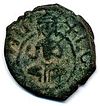
|
1289 Son of Thoros III and Margaret of Cyprus |
1305–1307 | Agnes of Tyre-Cyprus 1305 no children |
17 November 1307 Anazarba aged 17–18 |
Together with his uncle, he fought the Mongols, but were both assassinated in 1307. |
| Oshin (Օշին) |

|
3 January 1283 Fifth son of Leo III and Anna of Lampron |
1307–1320 | Isabella of Korikos c.1310 one son Isabelle of Cyprus 1310 (annulled c.1316)no children Joan of Taranto February 1316 Tarsus one child |
20 July 1320 aged 37 |
Ascended to the throne after the death of his nephew, Leo IV. He was poisoned by his cousin Oshin of Korikos. |
| Oshin of Korikos (Թորոս Բ) |
Unknown Son of Leo I |
1320–1329 | Marguerite d'Ibelin before 1320 one child Joan of Taranto 1320 one child |
8 February 1329 Sis |
Probably poisoned his cousin to rise as regent. | |
| Leo V (Լեիոն Դ) (Leo IV as king) |
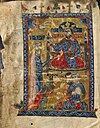
|
1309 Son of Oshin and Isabella of Korikos |
1329–1341 | Alice of Korikos 10 August 1321 one child Constance of Sicily 29 December 1331 no children |
28 August 1341 aged 31–32 |
Leo was strongly pro-Western and favored a union of the Armenian and Roman Churches, which deeply displeased the native barons. Murdered by them, they elected a cousin, from the Cypriot Lusignans. |
| Name | Portrait | Born | Reign | Marriage (s) | Death | Notes |
|---|---|---|---|---|---|---|
| Constantine IV (Կոստանդին Բ) (Constantine II as king) |
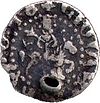
|
c.1300 Son of Amalric, Lord of Tyre and Isabella of Armenia |
1341–1344 | Kantakouzene c.1318 Constantinople no children Theodora Syrgiannaina c.1330 two children |
17 April 1344 aged c.43–44 |
Assassinated in an Armenian revolt in 1344. |
| Name | Portrait | Born | Reign | Marriage (s) | Death | Notes |
|---|---|---|---|---|---|---|
| Constantine V (Կոստանդին Դ) (Constantine III as king) |

|
17 April 1313 Son of Baldwin, Lord of Neghir |
1344–1362 | Marie of Korikos 1340 two children |
21 December 1362 aged c.43–44 |
During his rule, Armenian Kingdom of Cilicia was reduced by Mamluk raids and conquests. They conquered Ajazzo in 1347, Tarsus and Adana in 1359. |
| Marie of Korikos (Մարիա Կոռիկոսի) |
1321 Daughter of Oshin of Korikos and Joan of Taranto |
1362-c.1365 | Constantine V 1340 two children Constantine VI 1369 no children |
Before 1405 Jerusalem aged no more than 84 |
Managed the kingdom for three years, before the accession of Constantine VI. | |
| Constantine VI (Կոստանդին Բ) (Constantine IV as king) |

|
c.1324 Son of John, Lord of Neghir |
1365–1373 | Marie of Korikos 1369 no children |
April 1373 aged c.48–49 |
Cousin of his predecessor. Allied with Cyprus, and after 1369, with the sultan of Egypt. The barons disliked his policy because they feared the Muslim annexation, and murdered Constantine. |
| Name | Portrait | Born | Reign | Marriage (s) | Death | Notes |
|---|---|---|---|---|---|---|
| Leo VI (Կոստանդին Բ) (Leo V as king) |

|
c.1342 Son of John of Poitiers-Lusignan and Soldana of Georgia |
1373–1375 | Margaret of Soissons May 1369 one child |
29 November 1393 Paris aged 50–51 |
After several battles against superior Mamluk forces, he locked himself in the fortress at Geben (Armeina: Gaban) and eventually surrendered in 1375,[20] thus putting an end to the Kingdom of Armenia. |
Claimants
| Name | Lifespan | Reign start | Reign end | Notes | Family | Image |
|---|---|---|---|---|---|---|
| Leo VI | 1375 | 1393 | Lusignan |  | ||
| James I | 1396 | 1398 | Lusignan | |||
| Janus | 1398 | 1432 | Lusignan | |||
| John | 1432 | 1458 | Lusignan | |||
| Charlotte | 1458 | 1467 | Lusignan |  |
Potential claimants today
The title passed to the branch of the Lusignans in Constantinople and eventually Russia.[21] The title is contested by the House of Savoy and the House of Brienne via Hugh, Count of Brienne and John of Brienne.
See also
Notes
- ^ Kingdom of Greater Armenia (Bagratids)
- ^ (in Armenian) Poghosyan, S.; Katvalyan, M.; Grigoryan, G. et al. Cilician Armenia (Կիլիկյան Հայաստան). Soviet Armenian Encyclopedia. vol. v. Yerevan, Armenian SSR: Armenian Academy of Sciences, 1979, pp. 406–428
- ^ Kurdoghlian, Mihran (1996). Badmoutioun Hayots, Volume II (in Armenian). Athens, Greece: Hradaragoutioun Azkayin Oussoumnagan Khorhourti. pp. 29–56.
- ^ Mutafian, p.90
- ^ Lang, Robert Hamilton (1878), Cyprus, London: Macmillan and Co., p. 179, retrieved 2008-01-15
- ^ Ghazarian, Jacob G. The Armenian Kingdom in Cilicia during the Crusades: The Integration of Cilician Armenians with the Latins (1080–1093).
- ^ a b c d e f g h i j Template:MLCC
- ^ Ghazarian, Jacob G. The Armenian Kingdom in Cilicia during the Crusades: The Integration of Cilician Armenians with the Latins (1080–1093).
- ^ Ghazarian, Jacob G. The Armenian Kingdom in Cilicia during the Crusades: The Integration of Cilician Armenians with the Latins (1080–1093).
- ^ Ghazarian, Jacob G. The Armenian Kingdom in Cilicia during the Crusades: The Integration of Cilician Armenians with the Latins (1080–1093).
- ^ Ghazarian, Jacob G. The Armenian Kingdom in Cilicia during the Crusades: The Integration of Cilician Armenians with the Latins (1080–1093).
- ^ Ghazarian, Jacob G. The Armenian Kingdom in Cilicia during the Crusades: The Integration of Cilician Armenians with the Latins (1080–1093).
- ^ Ghazarian, Jacob G. The Armenian Kingdom in Cilicia during the Crusades: The Integration of Cilician Armenians with the Latins (1080–1093).
- ^ a b Vahan M. Kurkjian (2005-04-05). "A History of Armenia". Website. Bill Thayer. Retrieved 2009-07-19.
- ^ Ghazarian, Jacob G. The Armenian Kingdom in Cilicia during the Crusades: The Integration of Cilician Armenians with the Latins (1080–1093).
- ^ Ghazarian, Jacob G. The Armenian Kingdom in Cilicia during the Crusades: The Integration of Cilician Armenians with the Latins (1080–1093).
- ^ a b Runciman, Steven. A History of the Crusades – Volume II.: The Kingdom of Jerusalem and the Frankish East: 1100–1187.
- ^ Ghazarian, Jacob G. The Armenian Kingdom in Cilicia during the Crusades: The Integration of Cilician Armenians with the Latins (1080–1093).
- ^ Edwards, Robert W. The Fortifications of Armenian Cilicia.
- ^ Edwards, Robert W. (1987). The Fortifications of Armenian Cilicia: Dumbarton Oaks Studies XXIII. Washington, D.C.: Dumbarton Oaks, Trustees for Harvard University. pp. 10, 125, 234. ISBN 0-88402-163-7.
- ^ Cecil R. Humphery-Smith, Princes of Lusignan page 5 The Institute of Heraldic and Genealogical Studies 2004 and The colonel was probably known as Louis Christian de Lusignan. In the issue No. 180 of the Peterburgskiy Listok (Petersburg List) Newspaper July 3–15, 1884, a list of deceased in St Petersburg between 11 June and 18 June was found. There was a record for Louis Christian de Lusignan, colonel (retired). In the same newspaper issue No. 172 25 June – 7 July 1884, the following article was published: "The deceased who was buried thereby on Smolensk graveyard on 23 July, was a titled King of Cyprus and Jerusalem and Armenia, descendant of one of the protector of God's Casket, colonel of the Russian service, Louis de Lusignan."
References
- Boase, T. S. R. (1978). The Cilician Kingdom of Armenia. Edinburgh: Scottish Academic Press. ISBN 0-7073-0145-9.
- Mutafian, Claude (2001). Le Royaume Arménien de Cilicie. Paris: CNRS Editions. ISBN 2-271-05105-3.
- Histoire Des Princes de Lusignan, Anciens Rois de Jérusalem, de la Petite Arménie et de Chypre, St. Petersbourg, Soikine, Stremiannaya 12, 1903.
